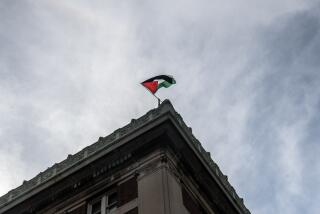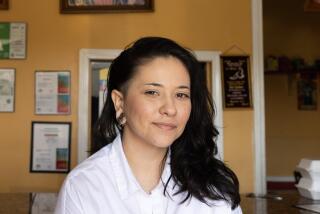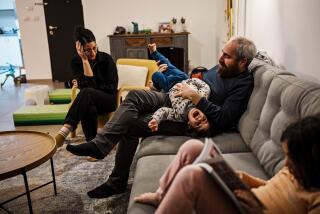Culture : Some Ethiopian Jews Still Praying to Leave : * 2,750 remain stranded, denied entry by Israel for converting to Christianity--a charge many deny.
- Share via
ADDIS ABABA, Ethiopia — When Israeli authorities spirited about 14,000 Ethiopian Jews to the Holy Land last May in the one-day airlift known as Operation Solomon, not everybody got a place on the planes.
Degu Abuni was one of those who was left behind. The 54-year-old former official of the Ethiopian Agriculture Ministry left his home in the northern province of Gondar in 1990, selling most of his belongings and moving to this capital city with his wife and children.
“We were told there that all the Jewish community would be leaving for Israel,” he says.
But when he went to the Israeli Embassy to register for immigration, “they said my name was not on the census list”--a reference to a 1976 census of Ethiopian Jews undertaken in Gondar by the Jewish relief organization ORT. “Then,” Abuni continues, “they said I was a Felas Mora. It was the first time I heard these words.”
No one knows the history of the term Felas Mora, which derives from the Amharic words for “horse fat.” But it is commonly used to refer to a group of Ethiopian Jews who in the 1970s converted to Christianity in their home villages. That act made them technically ineligible for the two-stage, mass exodus of Ethiopian Jews to Israel--first through Sudan in 1986-87, in what was known as Operation Moses, then last year via the Addis Ababa airlift.
Today, about 2,750 Felas Mora are becalmed in Addis Ababa, hundreds of miles from their homes, awaiting permission for emigration that may never come. Another 13,000 are estimated to be living in Gondar and Gojam provinces of northern Ethiopia.
The Israeli Embassy disavows any responsibility for them, leaving provision for their welfare in the hands of three American Jewish relief organizations working in Ethiopia.
An Israeli government commission last year declined to give a blanket ruling on their eligibility for immigration, recommending instead that their applications be considered on a case-by-case basis.
But no provision has yet been made for Israeli officials to come to Ethiopia to undertake that chore. To complicate matters further, leaders of the Ethiopian Orthodox Church have made it clear to the Israelis that they would view harshly any attempt to convert Ethiopian Christians to Judaism to facilitate their emigration.
The Felas Mora may present an even thornier problem of classification than did the original emigrant Ethiopian community, which waited for decades to be designated as Jews entitled under the so-called Law of Return to be automatically admitted to Israel as citizens.
“Their status is not known for certain,” says William Rekant, director of the American Assn. for Ethiopian Jewry, which is financing housing, health care and education for the Felas Mora in Addis Ababa.
Not all accept that the Felas Mora converted legitimately, least of all the people themselves. “We all practiced Judaism,” says Abuni. “We never went to church and married only among ourselves.”
Abuni and others among his community say confusion over their status came about because they settled in remote villages where Jews were a tiny minority. In his own settlement of Dembia, about 40 miles southwest of Gondar town, he was among five Jews in a community of 200 Christians. These communities were typically overlooked by the ORT census, which, although admittedly incomplete, became the basis for identifying Ethiopians eligible for exodus to Israel.
“I can say there is nobody here who was converted,” he says. “The assumption is that because this group was exposed to Christianity, they did not have the chance to practice Judaism.”
Many of the people still in Addis Ababa have immediate relatives who made it to Israel in previous migrations; Abuni has two brothers and two sisters there, and others even have children who reached the promised land, often with uncles and aunts.
“How can they be Jewish, and not me?” asks Malede Ayanaw, a former health worker stranded in Addis Ababa, whose two children reached Israel during Operation Solomon.
Some experts in the field say this may be overstating the case; there were conversions among Ethiopian Jews in the 1960s and 1970s, and many of those now in Addis Ababa undoubtedly were participants in the process. Conversion would not necessarily have covered everyone in the same immediate family, for families could be broken up by resettlement and children left in the care of relatives.
Still, the seriousness of any of these conversions is open to question. Many may have been done under duress, for Ethiopian Jews were subjected to assaults and their way of life restricted.
Further, in many cases the process of conversion was, at best, a perfunctory one, perhaps involving not more than a priest passing a hand over the subject and sprinkling some holy water about. Westerners working with the Felas Mora say that few, if any, appear to have actively practiced Christianity; the level of intermarriage between them and Ethiopian Christians seems to have been lower than among beneficiaries of operations Moses and Solomon.
Among the obstacles to admitting the Felas Mora are Israeli concerns that they represent the thin end of the wedge: that behind this relatively small group of even modestly Christianized people lies a multitude.
Because as many as 1 million Ethiopian Jews converted to Christianity around the turn of the century, hundreds of thousands of Ethiopians today could claim relatively recent Jewish heritage. In fact, given Ethiopia’s unique history as a crossroads of African-Middle Eastern travel and trade, many historians believe that, traced back far enough, almost every northern Ethiopian’s ancestry would show Jewish blood.
Israeli Ambassador Haim Divon acknowledges this is a concern. “We don’t know what the chain reaction would be,” he says, adding that the fate of the Felas Mora is the subject of “a public debate in Israel.”
The Israeli government is considering two possibilities. One is to find a clear criterion by which individuals can be accepted or rejected as Jews. The second, less difficult, option is to treat each case as a question of family reunification. This means that those who can show they have immediate family in Israel--parents, children, or siblings--would be permitted to join them.
Meanwhile, those stuck in Addis Ababa are living in and around two compounds not far from the Israeli Embassy itself, where they subsist at a somewhat better level than most Ethiopian refugees or displaced persons--indeed, better than did most evacuated in the airlift last May.
Donations from abroad help pay their rent in Addis Ababa and provide them with food and some clothing. They have access to a donor-funded medical clinic, which boasts perhaps the best-stocked pharmacy in Addis Ababa, continually replenished by the Western agencies. Tuberculosis is gradually being eradicated by a program operated out of the clinic. The community’s general health is much better than the airlifted groups, if only because its members have been in Addis Ababa so long that immunization and treatment programs have had a chance to bear fruit.
At one compound run by the North American Conference on Ethiopian Jewry and the American Joint Distribution Committee, about 750 people are kept at work spinning cotton into cloth used to fashion traditional garments. They also manufacture soap for sale in the Addis Ababa markets or make utilitarian knives out of tempered metal and blocks of wood (smithery was a trade restricted to Jews in Gondar).
“We feel very strongly that, in light of the fact that this isn’t a short-term program, they should earn their charity,” says Andrew Goldman, the North American Conference representative in Addis Ababa. “But it’s hard to find a niche where you can employ a lot of people in this economy.” Thus, much of the labor is busy work--moving stones around the compound or tending small gardens.
The Western organizations have registered their greatest success with the community’s 750 children, almost all of whom have now been taught in the compound’s 14 classrooms to read and write in their native Amharic. “Most of the kids had never been in school before,” Goldman says. Many are so well taught now that Goldman has enlisted them in a makeshift circus that travels to schools and hospitals around Addis Ababa giving free demonstrations of tightrope walking, unicycle riding and juggling.
“I had a nightmare that, when these kids got to Israel, there would be nothing they could do that would be better than an Israeli kid,” Goldman explains.
A local Canadian teacher agreed to teach them some of the necessary skills and now “virtually every kid over the age of 6 on this compound can juggle. We have the only kid in the world here who can ride a unicycle but not a bicycle.”
But this does not erase the reality that all such programs are necessarily finite. If the Israeli government rules finally that the Felas Mora are not entitled to emigrate, the Western agencies will eventually withdraw, leaving the clinic and compounds to the community but ending their funding.
In the interim, the Felas Mora bristle in limbo.
“It’s moral torture,” says Malede Ayanaw, the former health worker. “The (Israeli) Embassy doesn’t care about us, they never respond to anything. We don’t have a chance to learn Hebrew. But we can never go back to Gondar. We’ll die here, following our ancestors’ dream.”
More to Read
Sign up for Essential California
The most important California stories and recommendations in your inbox every morning.
You may occasionally receive promotional content from the Los Angeles Times.










